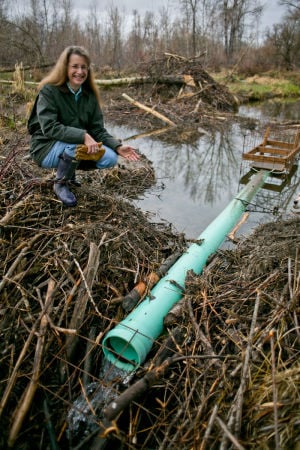It’s Sunday! Time for two great photos and some very good news! The first is from Austria’s Leopold Kanzler who has taken amazing photographs of beavers for years and is credited with many of my favorites. He just announced he is winning second place in a wildlife photo contest for this:

I think the courage necessary to hold very still under that particular tree deserves first place, don’t you?
I’ll share the second photo later, but for now let’s appreciate this sunny article about the beaver dams at Amy’s park, shall we?
Outdoors: Busy beavers unsung heroes at Amy’s Park

I’ve been oohing and aahing over beaver dams lately. There’s just something about them — maybe the feat of engineering achieved by a furry creature with a big tail and some really tough teeth, or the dams’ remarkable ability to reshape the landscape — that wows me every time!
We saw our most recent beaver dam at Amy’s Park in Bolton Landing.
The uneven little parking lot for the 500-acre preserve had just a single car in it when we pulled in around lunchtime one weekend. We set off along a woodsy trail under an overcast sky, stopping at a rocky outcrop to admire the view over a pond. We eventually hiked all the way around the preserve’s two ponds, finding a beaver lodge and numerous gnawed stumps.
The conservancy deserves a lot of credit for its work to protect the big lake. But I think we need to give the beavers a hand, too. Without them, there would be no ponds at Amy’s Park. The conservancy protects wetlands, but the busy beavers are the original architects of those environmental filtering systems.
Nicely put, Gillian Scott of the Time Union. We agree that beaver dams are a constant WOW. Thanks for the nicely written reminder. I assume you’re a friend of Beavers: Wetlands and Wildlife which isn’t far away. New Yorkers who care about beavers have to stick together. Speaking of which this ran recently in the New Yorker and of course has to be shared.

Ha! Now for the REALLY good news. We have been noticing that the water in the creek at Susana street is ponded up again, and that little visible dam has been nicely rebuilt. Yesterday we heard from two sources that they saw beavers in the area. One is our friend whose back deck opens up to the creek, and she took this with her phone on Friday. Hopefully she’ll get us more soon.






 The entire document is well prepared with a few jarring exceptions. It has the requisite shocking photos of dead beavers in traps or piled on trucks (which won’t do much in court), and isn’t careful about language enough for my tastes. (That paragraph alone spells “ensure” two ways without explanation) but its a HUGE shot across the bow, and every one from Michael Pollock to Ann Riley to Michael Callahan wrote me VERY interested in this yesterday. The reference section is thorough, indeed.
The entire document is well prepared with a few jarring exceptions. It has the requisite shocking photos of dead beavers in traps or piled on trucks (which won’t do much in court), and isn’t careful about language enough for my tastes. (That paragraph alone spells “ensure” two ways without explanation) but its a HUGE shot across the bow, and every one from Michael Pollock to Ann Riley to Michael Callahan wrote me VERY interested in this yesterday. The reference section is thorough, indeed.








 For CFC’s inaugural Beaver Month we chatted with Andrew Jakes, Regional Wildlife Biologist for National Wildlife Federation about the unsung bucktooth heroes of the watershed – the beaver.
For CFC’s inaugural Beaver Month we chatted with Andrew Jakes, Regional Wildlife Biologist for National Wildlife Federation about the unsung bucktooth heroes of the watershed – the beaver.
 Amy will share facts of about beaver ecology, review how beaver act as ‘ecosystem engineers’ in western watersheds, and share the implications lost beaver habitats on our water budget. Chadwick will be joined by Andrew Jakes, Wildlife Biologist with the National Wildlife Federation for a discussion of beaver habitat recovery work underway in the Upper Clark Fork and a Q & A session.
Amy will share facts of about beaver ecology, review how beaver act as ‘ecosystem engineers’ in western watersheds, and share the implications lost beaver habitats on our water budget. Chadwick will be joined by Andrew Jakes, Wildlife Biologist with the National Wildlife Federation for a discussion of beaver habitat recovery work underway in the Upper Clark Fork and a Q & A session.



































